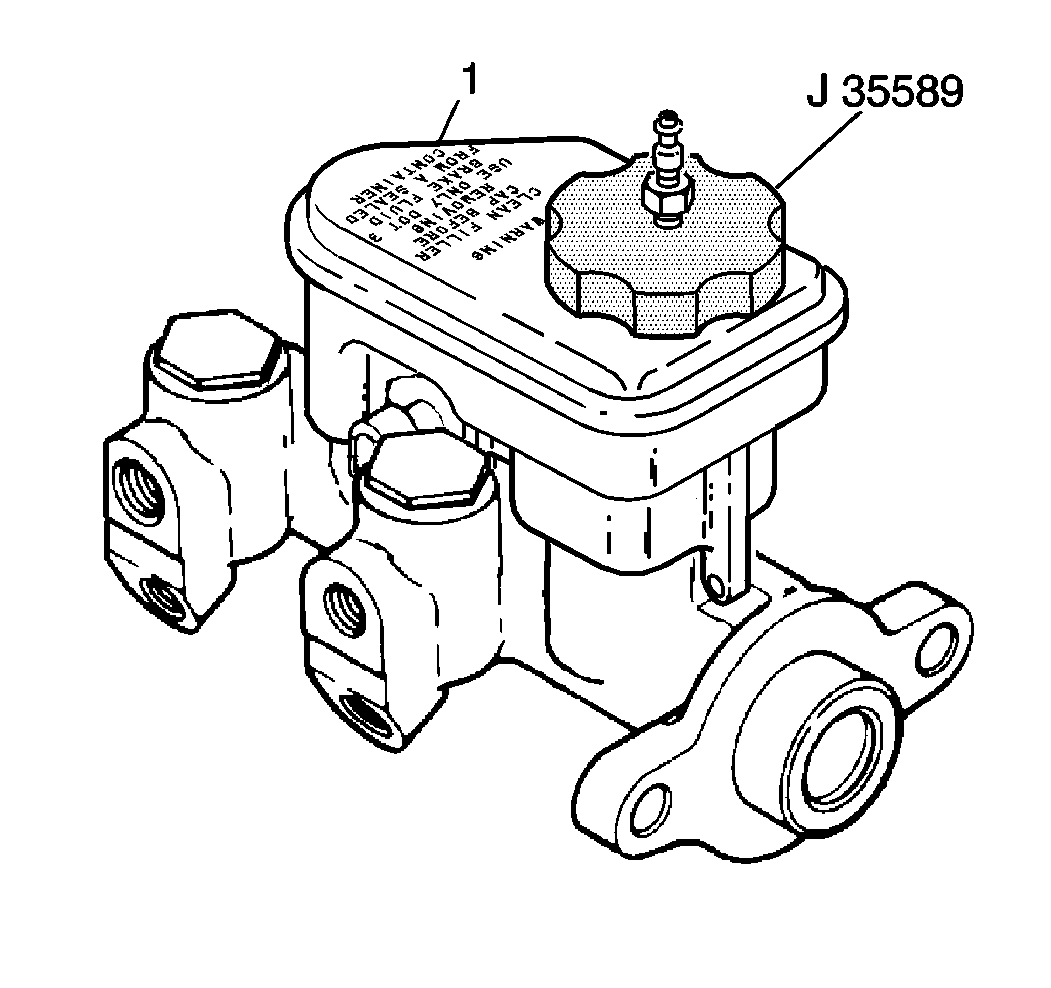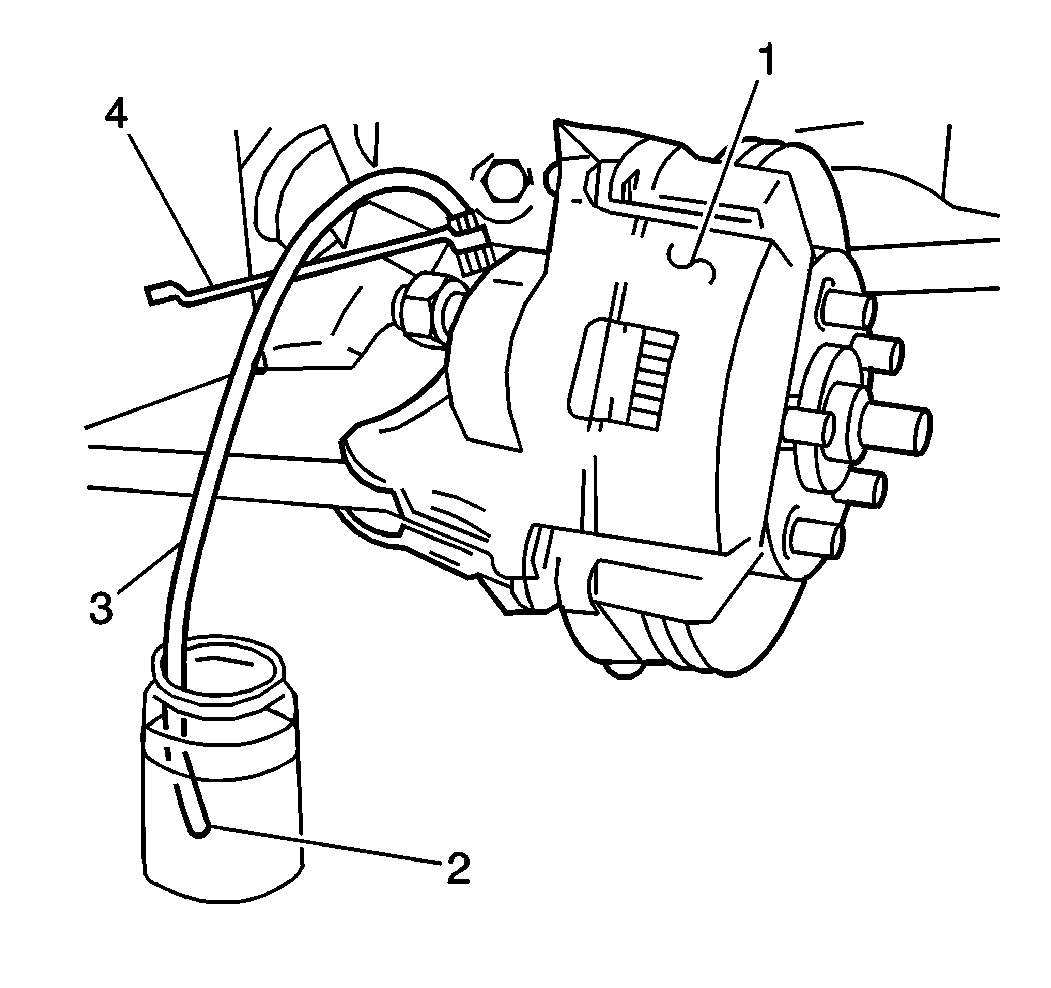Caution: Do not move the vehicle until a firm brake pedal is obtained. Air in
the brake system can cause the loss of brakes with possible personal injury.
Caution: Use only SUPREME 11 or equivalent DOT 3 brake fluid from a clean, sealed
container. Do not use fluid from an open container that may be contaminated
with water. Improper or contaminated fluid will result in damage to components
or loss of braking, with possible personal injury.
Caution: Do not overfill the brake fluid reservoir. Overfilling the brake fluid
reservoir may cause the brake fluid to overflow onto the engine exhaust components
during brake system service. The brake fluid is flammable and
may cause a fire and personal injury if the brake fluid contacts the engine
exhaust system components.
Notice: If any brake component is repaired or replaced such that air is allowed
to enter the brake system, the entire bleeding procedure must be followed.
Notice: Avoid spilling brake fluid on any of the vehicle's painted surfaces,
wiring, cables or electrical connectors. Brake fluid will damage paint and
electrical connections. If any fluid is spilled on the vehicle, immediately
flush the area with water to minimize the potential for damage.
A bleeding operation is necessary in order to remove air
when air is introduced into the hydraulic brake system.
Bleed the hydraulic system at all four brakes if air has been introduced
through a low fluid level or by disconnecting the brake pipes at the master
cylinder. If a brake hose or brake pipe is disconnected at one wheel, bleed
only that one wheel caliper. If brake pipes or hoses are disconnected at
any fitting located between the master cylinder and the brakes, then bleed
the brake system served by the disconnected pipe or hose.
Pressure Bleeding
Tools Required
| • | J 29532 Diaphragm
Type Brake Bleeder |
| • | J 35589 Compact
Brake Bleeder Adapter |
Notice: Pressure bleeding equipment must be of the diaphragm type. It must have
a rubber diaphragm between the air supply and the brake fluid to prevent air,
moisture, and other contaminants from entering the hydraulic system.
- Clean the brake fluid reservoir cover and the surrounding area.
- Remove the brake fluid reservoir cap.
- Inspect the brake fluid reservoir level. Refer to
Master Cylinder Reservoir Filling
.

- Connect the J 35589
to the brake fluid reservoir.
- Connect the bleeder adapter to the pressure bleeding equipment.
- Adjust the pressure bleed equipment to 35-70 kPa
(5-10 psi). Wait approximately 30 seconds in order to
ensure that there is no leakage.
- Adjust the pressure bleed equipment to 205-240 kPa
(30-35 psi).

Notice: Use the correct fastener in the correct location. Replacement fasteners
must be the correct part number for that application. Fasteners requiring
replacement or fasteners requiring the use of thread locking compound or sealant
are identified in the service procedure. Do not use paints, lubricants, or
corrosion inhibitors on fasteners or fastener joint surfaces unless specified.
These coatings affect fastener torque and joint clamping force and may damage
the fastener. Use the correct tightening sequence and specifications when
installing fasteners in order to avoid damage to parts and systems.
Important: Use a shop cloth in order to catch escaping brake fluid. Also, do not
allow brake fluid to contact any painted surfaces as surface damage will
occur. If brake fluid does contact any surface, flush the surface with water
to lessen the damage.
- Complete the following procedure with the pressure bleeding equipment
connected and pressurized:
- Raise and suitably support the vehicle. Refer to
Lifting and Jacking the Vehicle
.
- Bleed the brakes in the following sequence.
- Bleed the brakes in the sequence shown above. Complete the following
steps:
| 11.1. | Attach a clear plastic bleeder hose (3) to the bleeder
valve at the wheel. Submerge the opposite hose end in a clean container partially
filled with clean brake fluid. |
| 11.2. | Slowly open the bleeder valve. Allow the fluid to flow. |
| | Important: Ensure that the bleeder valves do not leak.
|
| 11.3. | Close the valve when the fluid begins to flow without any air bubbles.
Tap lightly on the caliper in order to dislodge any trapped air bubbles. |
Tighten
| • | Tighten the front caliper bleeder valves to 13 N·m
(115 lb in). |
| • | Tighten rear caliper bleeder valves to 7 N·m (62 lb in). |
- Remove the pressure bleeding equipment, including the J 35589
.
- Lower the vehicle.
- Inspect the brake fluid level in the reservoir. Fill the reservoir
to the proper level if necessary.
- Reinstall the brake fluid reservoir cap.
| 15.1. | Turn the ignition to the RUN position, then turn off the engine.
Apply the brake pedal with moderate force and hold. Note the pedal travel
and feel. |
| 15.2. | If the pedal feels firm and constant, and pedal travel is not
excessive, start the engine. With the engine running, re-check the pedal travel.
If the pedal travel is still firm and constant and pedal travel is not
excessive perform a road test on the vehicle. |
| 15.3. | Perform a road test on the vehicle. Make several normal (non-ABS)
stops from a moderate speed in order to ensure proper brake system function.
Allow adequate cooling time between stops. |
Manual Bleeding
Important: In the following procedure, use a suitable container or shop cloths
in order to catch the brake fluid and prevent the fluid from contacting any
painted surfaces.
- Clean the brake fluid reservoir cap and the surrounding area.
- Remove the brake fluid reservoir cap.
- Inspect the brake fluid level. Fill the reservoir to the correct
level if necessary.
- Install the brake fluid reservoir cap.

- Raise and properly support
the vehicle. Refer to
Lifting and Jacking the Vehicle
.
- Bleed the brakes in the following sequence.
- Bleed the brakes in the sequence shown above. Complete the following
steps:
| 7.1. | Attach a clear bleeder hose (3) to the bleeder valve at
the wheel. Submerge the opposite hose in a clean container partially filled
with clean brake fluid. |
| 7.2. | Open the bleeder valve. |
| 7.3. | Slowly depress the brake pedal. |
| 7.4. | Close the valve and slowly release the brake pedal. |
| | Important: In order to assist in freeing the entrapped air, tap lightly on the
caliper in order to dislodge any trapped air bubbles.
|
| | Important: Ensure that the bleeder valves do not leak.
|
| 7.6. | Repeat this entire procedure until the brake pedal feels firm at half
travel and no air bubbles are observed in the bleeder hose. |
Tighten
| • | Tighten the front caliper bleeder valves to 13 N·m(115 lb in). |
| • | Tighten the rear caliper bleeder valves to 7 N·m
(62 lb in). |
- Lower the vehicle.
- Remove the brake fluid reservoir. Fill the reservoir to the correct
level if necessary.
- Install the brake fluid reservoir cap.
- Turn the ignition switch to the RUN position, then turn off the
engine. Apply the brake pedal with moderate force and hold. Note the pedal
travel and feel.
- If the pedal feels firm and constant, and pedal travel is not
excessive, start the engine. With the engine running, recheck the pedal travel.
If the pedal feel is still firm and constant and pedal travel is not excessive,
skip the next step.
- If pedal feel is soft or has excessive travel either initially
or after engine start, repeat manual bleed procedure.
- Perform a vehicle road test. Make several normal (non-ABS) stops
from a moderate speed in order to ensure proper brake system function.



